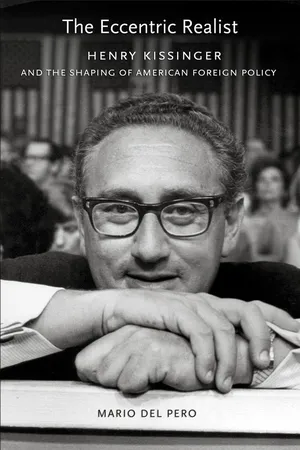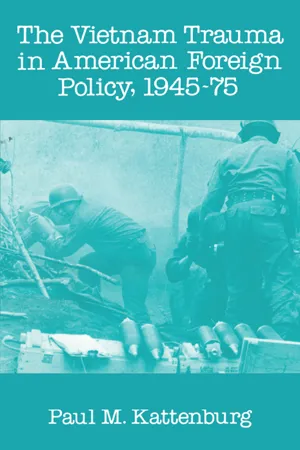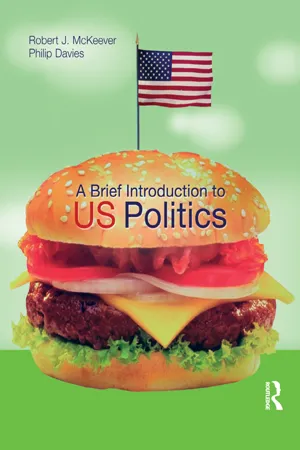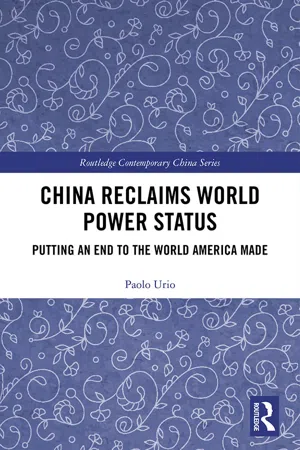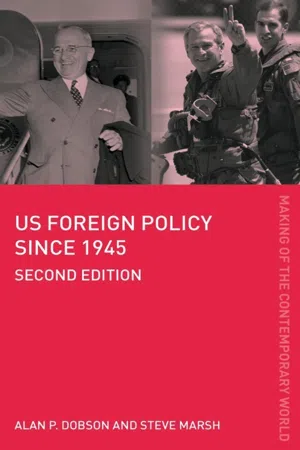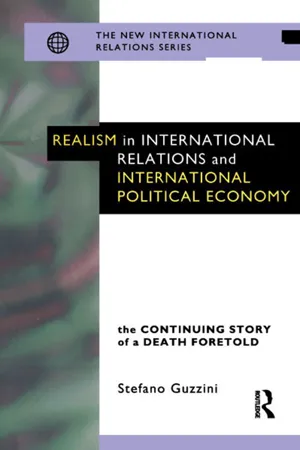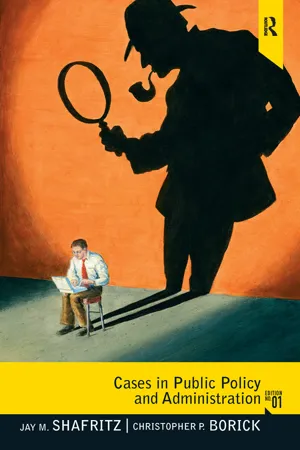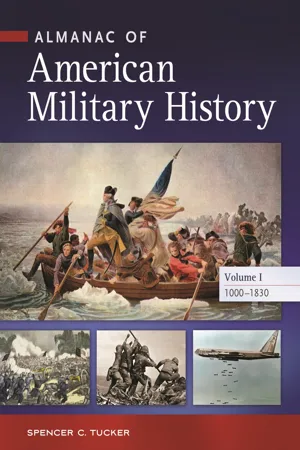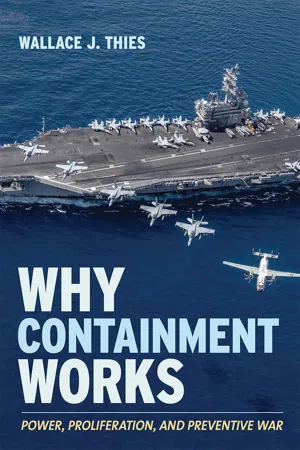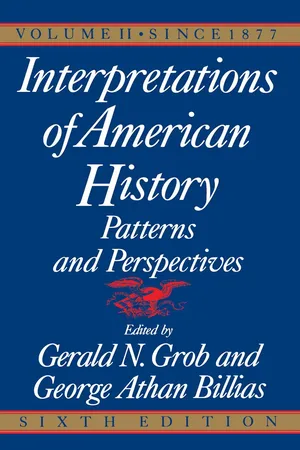History
US Policy of Containment
The US Policy of Containment was a foreign policy strategy adopted during the Cold War to prevent the spread of communism. It aimed to contain the influence and expansion of the Soviet Union and communism by providing economic and military aid to countries threatened by communist expansion. This policy guided US foreign relations and led to interventions in conflicts such as the Korean War and the Vietnam War.
Written by Perlego with AI-assistance
Related key terms
11 Key excerpts on "US Policy of Containment"
- eBook - ePub
The Eccentric Realist
Henry Kissinger and the Shaping of American Foreign Policy
- Mario Del Pero(Author)
- 2011(Publication Date)
- Cornell University Press(Publisher)
6Truman and his chief advisors enthusiastically accepted the prescriptions of Kennan’s containment: firmness, a rejection of dialogue, the construction of alliances, promotion of various “measures short of war,” and economic and political support to states menaced by Communism. For a couple of years, Kennan was an influential political advisor and led the Policy Planning Staff at the Department of State. His authority, however, rapidly waned, and during the rest of his life (which ended in 2005 at the age of 101) Kennan became a severe critic of U.S. foreign policy and the frequent misapplications of “his” containment.7Two objections that cut across political and cultural lines were initially raised to the strategy of containment from those who preferred the preservation of dialogue with Moscow, and from those, on the opposite side of the political spectrum, who urged instead a more resolute attitude and, possibly, the “liberation” of central Eastern Europe from Soviet domination. The first critique was more incisive and popular in the early postwar years, with famed intellectual and columnist Walter Lippmann presenting the argument in a series of articles, later collected in a single volume that popularized the other famous metaphor of the time: the Cold War.8 In particular, Lippmann denounced the paradoxically apolitical logic of Kennan’s containment and the abdication of diplomacy it entailed: because “the history of diplomacy,” Lippmann wrote, “is the history of relations among rival powers, which did not enjoy political intimacy . . . for a diplomat to think that rival and unfriendly powers cannot be brought to a settlement is to forget what diplomacy is all about.”9 - eBook - ePub
- Paul M. Kattenburg(Author)
- 2019(Publication Date)
- Routledge(Publisher)
Chapter II The Effects of Containment on U.S. Policies, 1945-59 1. Political and Ideological Aspects of Containment“Containment” was the name of the foreign policy doctrine adopted by the United States in the post-World War II period to counter Soviet moves which the United States regarded as hostile and threatening to its security interests. Perceptions of Soviet policy which led to U.S. containment included the following:1. That the Soviet Union harbored hegemonious designs over the entire region of Eastern Europe, which it had in effect annexed as a sphere of influence after World War II, and helped to install and maintain in each of the countries involved regimes willing to do its bidding.2. That the Soviet Union might threaten to extend its influence over areas of Western Europe and the Balkans (Greece and Turkey in particular) that it did not yet control.3. That, similarly, Soviet influence might spill over into regions of the “northern tier” of Middle Asia (specifically Iran, Afghanistan, Pakistan) into certain countries of the Middle East (Syria, Lebanon, and Iraq were the obvious targets, but Egypt and others offered possibilities), and might even extend into India.4. That the ideology of international communism compelled the spread of Soviet influence into “every nook and cranny” of the non-Communist, soon-to-be-dubbed “Free” World where it was not firmly resisted. U.S. Foreign Service officer George F. Kennan had used this colorful expression in his famous and anonymous article “The Sources of Soviet Conduct” by “X,” which appeared in the July 1947 issue of Foreign Affairs, the quarterly publication of the U.S. Council of Foreign Relations. The article was based on a lengthy telegram Kennan had dispatched from the U.S. embassy in Moscow to the Department of State in February 1946.5. That by firmly resisting Soviet pressures “at every point,” as suggested by Kennan. the United States might be able to thwart Soviet designs and thus to preserve a climate conducive to the plans and policies of the United States for a free, stable and accessible world political order. - eBook - ePub
- Robert J. Mckeever(Author)
- 2014(Publication Date)
- Routledge(Publisher)
Thus, American foreign policy-makers hoped that they could exploit their atomic monopoly and practise ‘atomic diplomacy’ upon the Soviets. Unfortunately, the Soviets reacted to these pressures in ways that only heightened tensions: ‘atomic diplomacy reinforced Russia’s security fears, strengthened its disposition to control its Eastern European buffer zone more tightly, undermined soft-liners on German policy, and led Soviet leaders to create a crash atomic bomb project of their own’ (McCormick, 1989, p. 45).ContainmentWherever the responsibility for the Cold War should lie, the fact is that in the years following the Second World War, relations between the United States and the Soviet Union deteriorated rapidly. Rightly or wrongly, from the American viewpoint the Soviet Union was an aggressive, expansionist state, armed with a messianic ideology that saw war with international capitalism as inevitable. This was the prism through which American policymakers viewed not merely Soviet conquests in eastern Europe, but the activities of all communists throughout the world.The decisive episode for US foreign policy came in 1947 and arose from the civil war taking place in Greece between local communists and royalists. Up to this point, Britain had been backing the royalists in an attempt to prevent the emergence of the first communist government in western Europe. Britain, however, was bankrupt and informed the United States that it could no longer sustain its effort. It also had to withdraw support from Turkey, which was coming under pressure from its Soviet neighbour.President Truman and his secretary of state, Dean Acheson, decided that the time had come to confront the Soviet threat. They had been primed for a new policy by the ideas of George Kennan, an American diplomat in Moscow. Kennan believed that the Soviet Union was inherently aggressive and must ‘be contained by the adroit and vigilant application of counterforce at a series of constantly shifting geographical and political points’. Thus, the policy of containment was born. Truman decided in 1947 that Greece and Turkey were the places to begin application of the doctrine.The Truman administration was ready to transform the United States into the ‘world’s policeman’ but he needed to persuade the American people and a Congress controlled by the opposition Republican party that such a new departure was necessary and in the best interests of the United States. At a meeting with congressional leaders in February 1947, Republican senator Arthur Vandenberg reportedly told Truman that if he wanted to get aid for Greece and Turkey from Congress, he would have to ‘scare hell out of the American people’. President Truman duly obliged in his address to Congress on 12 March 1947. In so doing, he gave his name to the Truman Doctrine, that is, a policy of global containment. - eBook - ePub
China Reclaims World Power Status
Putting an end to the world America made
- Paolo Urio(Author)
- 2018(Publication Date)
- Routledge(Publisher)
Taking now the elements presented in Chapter 2 for the analysis of power in the international system, let us first summarize the resources that the US possessed or could control and mobilize immediately after the end of the Second World War, for the purpose of establishing and maintaining its global leadership. This is, for me, the fundamental objective of US foreign policy, upon which all the other goals depend. It corresponds to China’s goal to reclaim world power status after the Western aggression of the nineteenth century, as I have explained in Chapter 1. For this purpose, the US has implemented several resources in the framework of a strategy that has become more and more complex to face the changes in the international system that developed after the end of the Second World War. Some may raise the question as to whether this strategy is based upon a rational analysis or is simply the implicit and conjunctural consequence of the US will to control the international system in order to protect the interests of its economy and more generally those of the US establishment. I am not interested in this question. It seems to me more important to understand the US strategy that can be discovered by using the statements by the different components of the establishment and the different types of actions implemented by the US administration.In fact, based upon the goal to establish and retain world power status, the fundamental guiding principle of US strategy since the end of the Second World War is certainly the containment of potential competitors. Clearly, expansion since the end of the Second World War could not be envisaged as it was in the nineteenth century when US power expanded in the Americas, as we have seen above. At the end of the Second World War, further expansion could only have been possible by implementing different means. It is here that containment becomes a fundamental principle to orient US foreign policy. The basic reasoning that founded the US Policy of Containment was defined by George Kennan in a telegram sent from Moscow to the Department of State, later published in the influential Foreign Affairs.124 It is interesting to see how the Historian of the Department of State explains and appreciates the policy of containment defined by Kennan:Few in the West had experience with the communist state and even fewer understood what motivated the Soviets. One man who had first-hand knowledge was a Foreign Service officer, George F. Kennan. In 1946, while he was Chargé d’Affaires in Moscow, Kennan sent an 8,000-word telegram to the Department, the now-famous ‘long telegram’, on the aggressive nature of Stalin’s foreign policy. Kennan, writing as ‘Mr. X,’ published an outline of his philosophy in the prestigious journal Foreign Affairs in 1947. His conclusion was that ‘the main element of any United States policy toward the Soviet Union must be that of a long-term patient but firm and vigilant containment of Russian expansive tendencies.’ Containment provided a conceptual framework for a series of successful initiatives undertaken from 1947 to 1950 to blunt Soviet expansion.125 - eBook - ePub
- Alan Dobson, Alan P. Dobson, Steve Marsh(Authors)
- 2007(Publication Date)
- Routledge(Publisher)
This combination of containment and the nuclear core of the Cold War had profound consequences for how and where the Cold War was fought, and for the US itself. While direct US–USSR nuclear war became countered by mutual vulnerability, the peaceful division of Europe as the Cold War front-line was maintained foremost through a tacit quid pro quo. US nuclear guarantees to NATO effectively offset perceived Soviet conventional superiority while the USSR countered NATO’s integration of conventional and battlefield nuclear weapons – essentially a first-strike doctrine – by stressing that even limited nuclear attack on its forces would be regarded as global nuclear war. This in turn progressively shifted the focus of the Cold War to the periphery and to limited superpower conflict by proxy, which often led US policy-makers to overlay complex regional problems with simplistic and frequently inappropriate containment prescriptions. As will be seen in subsequent chapters, the policies of the USSR were often lesser obstacles to US objectives than were power vacuums, economic dislocation, revolutionary nationalism and internecine dispute. In many cases US economic largess and supply of arms, military training and logistical support to proxy forces exacerbated indigenous problems, even if at the Cold War level US and Soviet initiatives were held in balance. Also, US policy-makers frequently faced difficult choices between American principles of democracy, anti-colonialism and national self-determination and the demands of maintaining beneficial short-term stability, which might best be served by cooperation with colonial powers and dictators, subverting democratic processes, or even armed intervention – especially in the Western Hemisphere in defence of the Monroe Doctrine.Containment also necessitated that the US develop an extensive network of allies and alliances throughout the Free World. These were sources of security contributions, political influence, strategic raw materials and offensive and defensive military bases – especially important before the development of ICBMs in ensuring Soviet nuclear vulnerability. At the same time these allies were often a significant drain on American resources, uncooperative in elements of American strategy and, especially in the Third World, less interested in the Cold War than in development and local antagonisms. As will be seen later, the Truman administration invested billions of dollars in European post-war economic and military recovery but Western Europe later posed significant economic challenges to the US and its member states often pursued policies not favoured by Washington – such as Ostpolitik, France’s force de frappe - eBook - ePub
Realism in International Relations and International Political Economy
The Continuing Story of a Death Foretold
- Stefano Guzzini(Author)
- 2013(Publication Date)
- Routledge(Publisher)
In the third stage of policy implementation, containment should help to bring about a long-term change in Soviet perceptions of International Relations. Containment was fundamentally a means to this ultimate end:(Kennan 1951: 127–8)The US has in its power to increase enormously the strains under which Soviet policy must operate, to force upon the Kremlin a far greater degree of moderation and circumscription than it has had to observe in recent years, and in this way to promote tendencies which must eventually find their outlet in either the breakup or the gradual mellowing of Soviet power. For no mystical, Messianic movement… can face frustration indefinitely without eventually adjusting itself in one way or another to the logic of that state of affairs.From early on, Kennan based his policy on the hope that internal reform would overcome dictatorship and expansion (Kennan 1951: 136–43). Indeed, in later writings, when the external front was fixed, he insisted that the real competition between the two systems should be fought on the domestic front. The victory in the Cold War depended not on what both systems could realize with their fancy weapons in space, but on their respective capacity to resolve their domestic problems and to realize the respective ideals. Asked where the US should oppose the Russian danger, he stated that it should start with those problems it did not yet solve and was ashamed of, such as, for example, the race issue, the misery in US cities, general and political education (Kennan 1958).Yet as an approach that attempted to both confront and reform an opposing system, containment would often have trouble keeping on a steady course. Sometimes containment policies were used to increase outside pressure on the Soviet society with the goal of forcing a collapse. For the fact of mutual nuclear deterrence, this more typical Cold War posture avoided open military conflict. But it pursued competition on all other levels, as, for instance, in the arms race, and competition for welfare state systems. At other times, containment was simply a form of detente policy based on the hope that the Soviet government would eventually adapt to a non-expansionist policy. This posture did not entail a relaxation of vigilance, but it relied on a long-term learning process. In the long years of the Cold War, containment as a long-term strategy has oscillated between these two poles. It comes as no surprise in the post-Cold War period, that the historical debate centres around whether the USSR collapsed from external or internal pressure. - eBook - ePub
Cases in Public Policy and Administration
From Ancient Times to the Present
- Jay M. Shafritz, Christopher P. Borick(Authors)
- 2015(Publication Date)
- Routledge(Publisher)
CHAPTER SEVENTEENHow the U.S. Strategic Policy of Containment (of Communism in General and the Soviet Union in Particular) Gradually Evolved Just After World War II to Win the Cold War in 1989PREVIEW
A cold war is a war with no traditional combat (in contrast to a “hot war”) that emphasizes ideological conflict, brinksmanship, and consistently high international tension. This is not new. Thomas Hobbes (1588–1679), the English social contract theorist so famous for observing that in a state of nature without a strong government, human life was “solitary, poor, nasty, brutish and short,” also had much to say about war. In Leviathan (1651), he wrote: “War consisteth not in battle only, or the act of fighting; but in a tract of time, wherein the will to contend by battle is sufficiently known.” Then he compared this “not in battle” war to bad weather. “For as the nature of foul weather, lyeth not in a shower or two of rain; but in an inclination thereto of many days together; so the nature of war, consists not in actual fighting; but in the known disposition thereto, during all the time there is no assurance to the contrary. All other time is peace.”In the twentieth century, “the” Cold War was the hostile but (in the Hobbesian tradition) nonlethal relations between the United States and the Soviet Union that began in 1945 after World War II and ended in 1989 with the dismantling of the Berlin Wall that divided East from West Germany and was the symbol for the Soviet domination of Eastern and Central Europe. By 1991 the Soviet Union itself was dismantled and replaced by constituent republics formed into a loose confederation known as the Commonwealth of Independent States. Credit for the modern use of “cold war,” for the revival of Hobbes’s concept, goes to journalist Herbert Bayard Swope (1882–1958), who first used it in speeches he wrote for financier Bernard Baruch (1870–1965). After Baruch told the Senate War Investigating Committee on October 24, 1948, “Let us not be deceived—today we are in the midst of a Cold War,” the press picked up the phrase, and it became part of everyday speech. - eBook - ePub
Almanac of American Military History
[4 volumes]
- Spencer C. Tucker, Spencer C. Tucker, Spencer C. Tucker(Authors)
- 2012(Publication Date)
- ABC-CLIO(Publisher)
Foreign Affairs . The article articulated his policy of containing Communism where it already existed at that time and actively preventing its spread to other countries. Dubbed the Containment Doctrine, this policy became the foundation of U.S. policy during the Cold War and was enthusiastically embraced by U.S. president Harry Truman.Primary Source
[. . .] PART THREE: PROJECTION OF SOVIET OUTLOOK IN PRACTICAL POLICY ON OFFICIAL LEVEL We have now seen nature and background of Soviet program. What may we expect by way of its practical implementation? . . . On official plane we must look for following:(A) Internal policy devoted to increasing in every way strength and prestige of Soviet state’s intensive military-industrialization; maximum development of armed forces; great displays to impress outsiders; continued secretiveness about internal matters, designed to conceal weaknesses and to keep opponents in dark.(B) Wherever it is considered timely and promising, efforts will be made to advance official limits of Soviet power. For the moment, these efforts are restricted to certain neighboring points conceived of here as being of immediate strategic necessity, such as Northern Iran, Turkey, possibly Bornholm. However, other points may at any time come into question, if and as concealed Soviet political power is extended to new areas. Thus a “friendly” Persian Government might be asked to grant Russia a port on Persian Gulf. Should Spain fall under communist control, question of Soviet base at Gibraltar Strait might be activated. . . .(C) Russians will participate officially in international organizations where they see opportunity of extending Soviet power or of inhibiting or diluting power of others. Moscow sees in UNO [United Nations Organization] not the mechanism for a permanent and stable world society founded on mutual interest and aims of all nations, but an arena in which aims just mentioned can be favorably pursued. As long as UNO is considered here to serve this purpose, Soviets will remain with it. But if at any time they come to conclusion that it is serving to embarrass or frustrate their aims for power expansion and if they see better prospects for pursuit of these aims along other lines, they will not hesitate to abandon UNO. . . . Moscow has no abstract devotion to UNO ideals. Its attitude to that organization will remain essentially pragmatic and tactical. - eBook - ePub
Cornell Studies in Security Affairs
Power, Proliferation, and Preventive War
- Wallace J. Thies(Author)
- 2020(Publication Date)
- Cornell University Press(Publisher)
7 These requirements put a premium on ingenuity and innovation—finding new ways to get some leverage from weapons that were widely thought to be unusable. Here was an obvious challenge. Did the United States meet the standard being proposed? Was the requisite ingenuity actually forthcoming? A strong case can be made that the answer to these questions is yes.As the Cold War began, adoption of a containment policy by the Truman and Eisenhower administrations was a way of saying that time was on our side, and that “the Soviet Union would eventually collapse or mellow from internal stresses and strains.”8 Even so, “the steady growth of Soviet power and the expansion of Communist influence in Asia were facts of life during the Cold War. American military policy confronted not a condition but a trend.”9 A containment policy required much more than just flipping a switch from off to on. Containment required a more or less continual set of adjustments, sized and shaped to respond to whatever the Communist side was doing now. This made containment seem very burdensome, but hindsight suggests there are multiple reasons why a superpower that was also a democracy would be very well-suited to sustaining a containment policy for four decades or longer.First, United States was so blessed with resources, both material and intellectual, that only one other state (the Soviet Union) could hope to match within a reasonable time frame. George Kennan provided a cogent explanation for why the Soviets acted as they did, initially in his famous “Long Telegram” from Moscow in January 1946 and then in his even more influential article, “The Sources of Soviet Conduct,” which appeared in the journal Foreign Affairs in July 1947.10 - eBook - ePub
- Gerald N. Grob, George Athan Billias(Authors)
- 2010(Publication Date)
- Free Press(Publisher)
The orthodox interpretation was presented in scholarly books and journals in the late 1940s and early 1950s by historians like Herbert Feis and policymakers such as George F. Kennan. These men, too, held that the Cold War had been brought about mainly because of Soviet actions. Motivated by the traditional desires for greater security, power, and larger spheres of influence, they said, the Soviet Union resorted to an expansionist foreign policy. Coupled with these age-old drives was the new ideological zeal of communism which made the Soviets ambitious to foment revolution and conquest in behalf of their cause. Scholars sometimes disagreed about the primary motivation of the Soviets; some favored the importance of ideology as an explanation, while others believed the main focus should be placed on Russia’s traditional policy of imperialism and pursuit of national interest. But they all tended to agree that no matter what the motivation might be, Soviet objectives were expansionist in scope. The orthodox view also argued that the Soviet Union violated its agreements with the Western powers, including the Yalta accords as they concerned the political future of Eastern Europe and, to a lesser extent, the role of China in the postwar world.America’s foreign policy, according to the orthodox interpretation, was in marked contrast to that of the Soviet Union. The United States, at first, held high hopes for a peaceful postwar world. The actions of its leaders were predicated on the principles of collective security, and they looked to the newborn United Nations for the solution to any future conflicts. Faced with Soviet aggressive moves, however, America was reluctantly forced to change its views and foreign policy. To prevent the Soviet Union from spreading its influence over large parts of the world, the United States finally felt compelled to embark upon a policy of “containment.” Without this containment policy, argued many, the Soviet Union would probably have become the master of all Europe—instead of dominating only Eastern Europe.Many of the arguments of the orthodox position were set forth in an article published by George F. Kennan under a pseudonym, “Mr. X,” in 1947. Kennan, an American diplomat, provided many of the insights upon which the foreign policy of the Truman administration was based. In his piece Kennan suggested, among other things, an American containment policy to check Russia’s expansionist tendencies. Kennan subsequently claimed, however, that he was not thinking primarily in terms of containment along military lines.2 - eBook - ePub
Kennan and the Cold War
An Unauthorized Biography
- David Felix(Author)
- 2017(Publication Date)
- Routledge(Publisher)
in short, as strategic-political doctrine.” In the face of atomic weapons, Kennan thought, the nations “would now have to revert to the concepts of limited warfare prevalent in the eighteenth century.” 16 But this tersely sketched policy would carry him beyond his War College period and demand more elaboration. Meanwhile, in his NWC and related lectures, Kennan developed his Cold War strategy. The first of the lectures, “Measures Short of War,” accurately sufficed as the title of the compilation of all thirteen lectures. 17 A forward by the NWC president explained that the lectures were an “experiment in co-educating military and civilian leaders.” In the first lecture Kennan explained the sense of all, indeed, the sense of his containment policy: “Our pacifists are incapable of understanding that the maintenance of strength. . . is actually the most peaceful of all the measures we can take short of war.” This was “because the greater your strength, the less likely you are ever going to use it. . . . [T]here was no real security. . . no alternative to living dangerously.” He concluded, “And when people say, ‘My God, we might get into war!’ the only thing I know to say is, ‘Exactly so.’ The price of peace has become the willingness to sacrifice it to a good cause.” 18 Thus, eloquently, containment. A parallel to this unflinching statement was provided by Secretary of State John Foster Dulles in a 1956 interview. Earlier, during the 1952 presidential campaign, the Republican Dulles had championed the conception of “liberation” as a braver policy than containment, but that had been campaign rhetoric. The effective Dulles policy defined itself as containment. In the 1956 interview Dulles said, “You have to take chances for peace, just as you must take chances in war. . . . The ability to get to the verge without getting into war is a necessary art. If you try to run away from it. .
Index pages curate the most relevant extracts from our library of academic textbooks. They’ve been created using an in-house natural language model (NLM), each adding context and meaning to key research topics.
